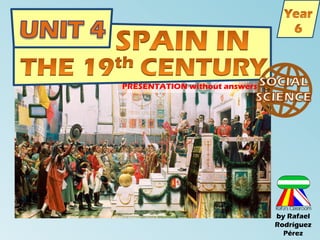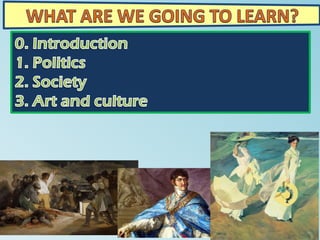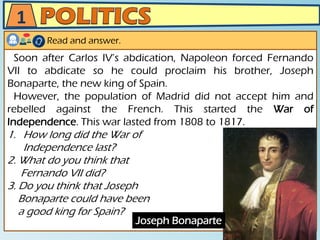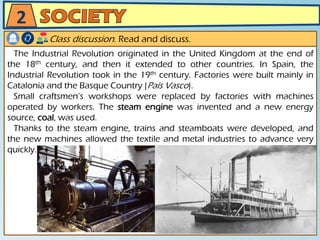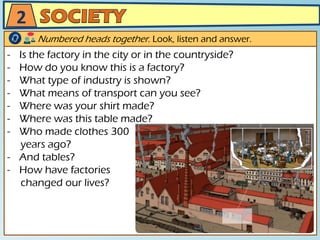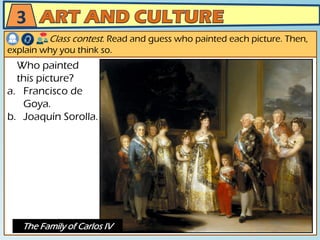Presentation: Spain in the 19th century
- 5. Look, read and discuss about facts that you remember from Year 5. No children Expulsion of the Moriscos 1598 1621 30 Years’ War Portugal became independent 1665 War of Succession - Bourbon dynasty had the victory 17th CENTURY Modernized the country Spanish language 18th CENTURY 1700 Salic Law 1746 Continued the reforms Built roads and canals 1759 libraries and the Prado Museum Menorca became Spanish 1788 Unpopular king
- 7. In 1807, when Carlos IV was the king of Spain, something happened. Napoleon Bonaparte, the Emperor of France, made a decision: to occupy Portugal. Carlos IV allowed him to go across Spain to go to Portugal. However, the French troops invaded some Spanish cities when they were travelling to Portugal. 1. What was Napoleon Bonaparte’s real intention? Why? 2. Do you think French troops conquered all our country? 1-2-group. Read about the War of Independence and answer. 1 Carlos IV Napoleon Bonaparte
- 8. This caused a popular revolt (Motín de Aranjuez) which forced Carlos IV to abdicate. His son, Fernando VII, became king. Whole class activity. Read and guess. Do you think Fernando VII stopped French invasion? I don’t want to be the king anymore. My son will be the king now. Carlos IV Fernando VII 1
- 9. Soon after Carlos IV’s abdication, Napoleon forced Fernando VII to abdicate so he could proclaim his brother, Joseph Bonaparte, the new king of Spain. However, the population of Madrid did not accept him and rebelled against the French. This started the War of Independence. This war lasted from 1808 to 1817. 1. How long did the War of Independence last? 2. What do you think that Fernando VII did? 3. Do you think that Joseph Bonaparte could have been a good king for Spain? Read and answer. Joseph Bonaparte 1
- 10. Soon after Carlos IV’s abdication, Napoleon forced Fernando VII to abdicate so he could proclaim his brother, Joseph Bonaparte, the new king of Spain. However, the population of Madrid did not accept him and rebelled against the French. This started the War of Independence. This war lasted from 1808 to 1817. 1. How long did the War of Independence last? 2. What do you think that Fernando VII did? 3. Do you think that Joseph Bonaparte could have been a good king for Spain? Numbered heads together. Read and answer. Joseph Bonaparte Act out in groups. Pretend to travel in time and calm down the citizens of 1808. They were in panic! 1
- 11. Draw this picture in a sheet of paper and describe it. 1 The 3rd of May 1808, by Francisco de Goya
- 12. When the French were defeated in 1814, Fernando VII returned as the king of Spain. During the war, the Spanish Parliament moved to Cádiz. In 1812, its members wrote the 1st constitution of Spain, the Constitution of Cádiz. It limited the king’s power and established rights for citizens, including the right to vote for men twenty-five years old or older. - Do you think that Fernando VII liked the Constitution of Cádiz? - Do you know another name for the Constitution of Cádiz? Class discussion. Read and discuss. 1
- 13. Viva la Pepa! After a long and dangerous journey, I arrive in Cádiz to go to a secret meeting. It is not my first time here; two years ago, in 1812, I was part of a big celebration for the approval of the Constitution of Cádiz, the first Spanish constitution. We call it La Pepa because it was approved on 19th March, Saint Joseph’s Day. We believed the Constitution would help modernize Spain. The Constitution recognized Fernando VII as king, but it also included new ideas, such as making all men equal and protecting freedom of the press. The Constitution only lasted two years, and now they arrest everybody that supported it. A man walks next to me in the street and whispers: ‘Viva la Pepa!’ It is our motto. I promise myself to never stop defending ideas like equality, liberty and justice. 1. Where does this short story happen? In what year? 2. Why was the first Spanish Constitution called ‘La Pepa’? 3. What ideas did it include? 4. Why is the character in the story going to a secret meeting? 5. How was the expression ‘Viva la Pepa!’ used? Individual activity. Read, understand and answer. 1
- 14. In 1814, when the war finished, Fernando VII returned as king of Spain. He abolished the Constitution of Cádiz and re- established an absolute monarchy. This caused political disorder and, as a result, most of the American colonies became independent. Also, the liberals* were persecuted. *liberals: people who supported the Constitution. Thinking twins. Read in pairs and write a list of two positive aspects about the absolute monarchy and about La Pepa. Discuss. 1
- 15. In Spain, according to the law of succession, only men could reign. However, Fernando VII changed this law, so his daughter could ascend to the throne. Isabel II became queen when Fernando VII died in 1833. - What law did Fernando VII change? - Why did he change it? - Fernando VII’s brother, Carlos María Isidro, didn’t like the new law of succession. Why do you think he didn’t like it? Whole class activity. Read and answer orally. 1
- 16. 1 Isabel II was 3 years old when she became queen of Spain. However, she didn’t reign until she was 13 years old. During that period, her mother, María Cristina de Borbón, assumed her regency first and, later, general Baldomero Espartero did. During her reign, there was a constitutional monarchy that limited her power. However, numerous military conflicts and changes of government led to a revolution, and in 1868, Isabel II went into exile. Whole class activity. Read and answer these questions orally.
- 17. Isabel II was 3 years old when she became queen of Spain. However, she didn’t reign until she was 13 years old. During that period, her mother, María Cristina de Borbón, assumed her regency first and, later, general Baldomero Espartero did. During her reign, there was a constitutional monarchy that limited her power. However, numerous military conflicts and changes of government led to a revolution, and in 1868, Isabel II went into exile. Whole class activity. Read and answer these questions orally. - How do you think a 3-year-old girl would govern Spain? - Explain to your partner why a regency is important. 1
- 18. After Isabel II’s exile, a new constitution was created. It established a monarchy in Spain, but there was a problem: there was no king! In 1871, Amadeo de Saboya of Italy became king. However, since he was a foreign king, he did not have much support, and he abdicated two years later. In 1873, members of Parliament proclaimed a republic, a form of govern with no king. It was the 1st time that the Spanish Head of State was not a king, but a president chosen by citizens. However, it didn’t have much support and failed after about one year. Thinking twins. Read this information and write your opinion briefly. 1
- 19. Use 7 linkers and 150 words at least. Write about the War of Independence, Fernando VII, Isabel II, Amadeo de Saboya and the first republic. Use your own words. PARAGRAPH 1: INTRODUCTION PARAGRAPH 2: 1st BODY PARAGRAPH 3: 2nd BODY PARAGRAPH 4: CONCLUSION 1
- 20. In 1874, the son of Isabel II, Alfonso XII, was crowned king of Spain, and a new historical period known as the Restoration, began. Alfonso XII died in 1885 and his son, Alfonso XIII, became king of Spain. His mother, María Cristina governed for him until he was 16 years old. At the end of the 19th century, during María Cristina’s regency, Spain lost its last colonies in Cuba, Puerto Rico and the Philippines. Read this information. Alfonso XII Alfonso XIII María Cristina 1
- 21. In 1874, the son of Isabel II, Alfonso XII, was crowned king of Spain, and a new historical period known as the Restoration, began. Alfonso XII died in 1885 and his son, Alfonso XIII, became king of Spain. His mother, María Cristina governed for him until he was 16 years old. At the end of the 19th century, during María Cristina’s regency, Spain lost its last colonies in Cuba, Puerto Rico and the Philippines. Read this information. Alfonso XII Alfonso XIII María Cristina Work in groups. Make a timeline of Spanish monarchs in the 19th century. Include the years they ruled and important events. 1
- 22. 1885 Constitutional monarchy Not much support abdicated 1st Constitution Carlos IV allowed Napoleon to go across Spain to go to Portugal. 1807 1808 1812 abolished the 1st Constitution 1814 absolute monarchy 1833 Exile 1871 1873 1st republic War of Independence 19th CENTURY 1874 Not much support Most of the American colonies became independent 19th CENTURY Restoration
- 24. The Industrial Revolution originated in the United Kingdom at the end of the 18th century, and then it extended to other countries. In Spain, the Industrial Revolution took in the 19th century. Factories were built mainly in Catalonia and the Basque Country (País Vasco). Small craftsmen’s workshops were replaced by factories with machines operated by workers. The steam engine was invented and a new energy source, coal, was used. Thanks to the steam engine, trains and steamboats were developed, and the new machines allowed the textile and metal industries to advance very quickly. Class discussion. Read and discuss. 2
- 25. 2 Numbered heads together. Look, listen and answer.
- 26. - Is the factory in the city or in the countryside? - How do you know this is a factory? - What type of industry is shown? - What means of transport can you see? - Where was your shirt made? - Where was this table made? - Who made clothes 300 years ago? - And tables? - How have factories changed our lives? 2 Numbered heads together. Look, listen and answer.
- 27. 2 Dictation. Write and discuss.
- 28. - A society that was based on agriculture transformed into a society based on industrial activities. - The most important industry of Andalusia during the Industrial Revolution was the Iron Industry. Dictation. Write and discuss. 2
- 29. Society in the 19th century was divided into three social classes, based on wealth. - The upper class consisted of the wealthiest people: • the aristocrats. They were nobles who had large areas of land. • the bourgeois. They were people who had factories, prosperous merchants and bankers. - The middle class consisted of small merchants and entrepreneurs, small landowners, and professionals such as doctors, lawyers and engineers. - The lower class consisted of poorer people: • peasants. They worked on the land of large landowners. • factory workers. They worked in factories and they got a salary. Their living conditions were very hard. They worked more than 12 hours a day for very low salaries. They lived in areas of the city with no electricity or running water. In addition, many children worked in factories for salaries even lower than those paid to adults. These workers wanted to protect their interests, so they formed groups known as labour unions. Individual activity. Read, look and join the STORY CONTEST. 2
- 30. Individual activity. Read, look and join the STORY CONTEST. upper class middle class lower class aristocrats bourgeois peasants factory workers etcetera 2
- 31. SHORT STORY CONTEST! Write a story of people from different social classes in the 19th century. Include some information about this century. Remember to use past simple and past continuous. Individual activity. Read, look and join the STORY CONTEST. 2
- 33. ARCHITECTURE - At the beginning of the 19th century, neoclassical architecture developed. Buildings were constructed in a style similar to that of Greek and Roman architecture. - During this century, iron bridges were built and new types of buildings were created, such as railway stations made of iron and glass. - At the end of the century, a new architectural style, known as Modernism, was born. Modernist buildings show curved and wavy shapes that simulate forms in nature. In Spain, the most famous modernist architect was Antoni Gaudí, creator of the Casa Milà in Barcelona. Read and match pictures and architectural styles. 3 Antoni Gaudí
- 34. Read and match pictures and architectural styles. Railway station in Almería Neoclassical architecture New types of buildings with iron and glass Modernism 3
- 35. SCULPTURE The transformation of cities influenced sculpture. During this century, squares, gardens and avenues were decorated with beautiful sculptures made mainly of stone. One of the most famous sculptors was Ricardo Bellver. Thinking twins. Read this information and answer. El ángel caído (The Fallen Angel) by Ricardo Bellver Do you think that sculptures have transformed cities and towns? How? Explain. 3
- 36. PAINTING At the beginning of the 19th century, Francisco de Goya was painter at the Spanish Court and painted portraits of Carlos IV and Fernando VII. However, he also painted popular scenes such as festivals and wine harvests. Goya is considered one of the greatest artist in history. At the end of the 19th century, Impressionism was born. This art movement introduced innovative painting techniques. Impressionists painters put more emphasis on colour than drawing, as well as on the effect of light in landscapes. The most important Spanish impressionist painter was Joaquín Sorolla. Class contest. Read and guess who painted each picture. Then, explain why you think so. 3
- 37. Who painted this picture? a. Francisco de Goya. b. Joaquín Sorolla. The Family of Carlos IV Class contest. Read and guess who painted each picture. Then, explain why you think so. 3
- 38. Who painted this picture? a. Francisco de Goya. b. Joaquín Sorolla. Women Walking on the Beach Class contest. Read and guess who painted each picture. Then, explain why you think so. 3
- 39. LITERATURE During the 19th century, there were great writers in Spain. You could find them in the 3 genres of literature: - Narrative: Benito Pérez Galdós and Leopoldo Alas ‘Clarín’. - Poem: Rosalía de Castro and Gustavo Adolfo Bécquer. - Drama: José Zorrilla, who wrote Don Juan Tenorio. Memorize their faces and names in 1 minute: Read and match these writers and their genres of literature. 3
- 40. LITERATURE Read and match these writers and their genres of literature. 3
- 41. LITERATURE At the end of the century, when Spain lost its last colonies in America, a group of writers known as the Generation of ‘98 wrote pessimistically about the social and political situation of Spain. This group included writers such as Pío Baroja, Miguel de Unamuno, Antonio Machado and Ramón María del Valle-Inclán. - What was the Generation of ‘98? - Name three writers who belonged to this group. - If you were a writer at the end of the 19th century, would you be part of the Generation of ’98? Why? Individual activity. Read and answer. Know the writers from the Generation of ‘98. 3
- 42. LITERATURE The Generation of ‘98 3 Individual activity. Read and answer.
- 43. Group work. Copy this table in your notebook and complete. POLITICS SOCIETY ARTS
